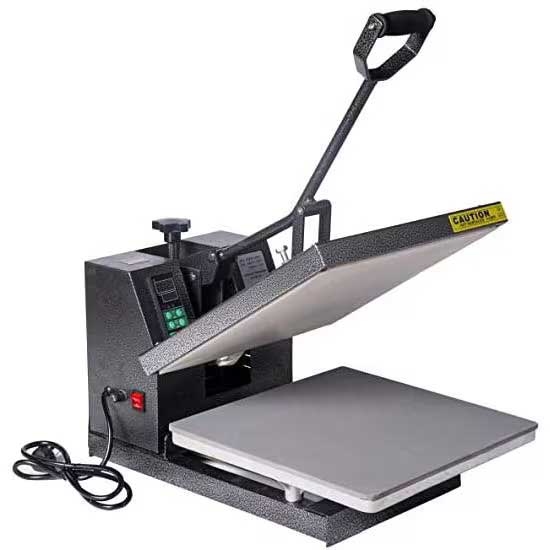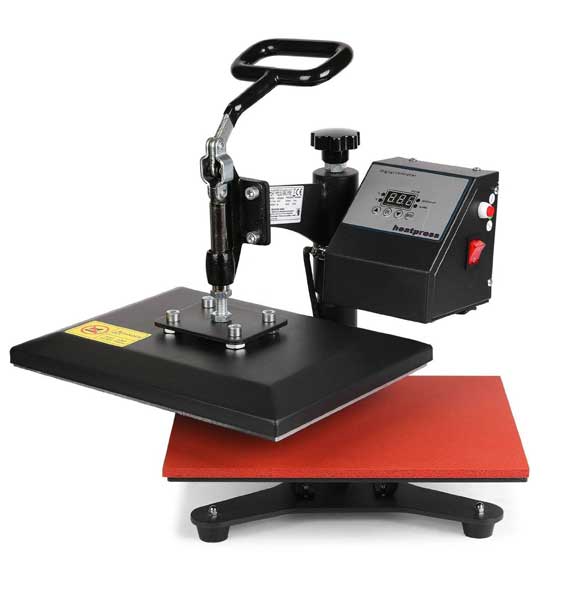If you have a heat press, you can do professional t-shirt printing at home using various methods such as printed DTF film, printed sublimation sheet, or screen-printed heat transfer film. As a beginner, there’s no need to invest in DTF or a sublimation printer. Instead, you can create a design and send it to a t-shirt printing shop to get the printed sheet for heat transfer.
Heat Press: As the name suggests, heat and pressure are applied for image printing through heat transfer. Different sizes are available, with the most commonly used ones being 11” x 15”, 16” x 16”, and 16” x 20”. The heat press consists of an upper platen and a lower platen. Inside the upper platen, a network of heating coils is placed, and the temperature is regulated by a control unit, adjustable up to 220 degrees Celsius. Pressure is regulated by a large screw-like knob, which can be rotated clockwise or counterclockwise depending on the fabric or substrate thickness. Medium pressure is usually enough for normal heat transfer.
Control Unit: The control unit also includes a timer to indicate the duration of the heat transfer process. The recommended timings for DTF heat transfer are 150 degrees Celsius for 5-10 seconds and for sublimation, 195 degrees Celsius for 50-60 seconds.
Types of Heat Press: There are different types of heat presses available in the market, with the most commonly used models being Clamshell and Swing away.

Clamshell Model: This model opens and closes like a clam, with a maximum opening angle of 450 degrees. It is relatively affordable, making it ideal for beginners. The Clamshell heat press is easy to operate, requires less space, and has a straightforward control unit.

Swing Away Type: The Swing Away heat press allows you to move the top platen to the left or right as needed. It provides uniform pressure and is more energy-efficient. However, it requires more working space due to the movement of the platen. High-end costly models are available with options for different platen sizes based on the fabric’s size.
Precautions: Pre-press the fabric for 5-7 seconds before heat transfer to remove any moisture present in the fabric. This step is crucial for ensuring a long-lasting printed image, especially in humid conditions.
Correct temperature and pressure are essential for quality transfer. For example, DTF heat transfer requires 150 degrees Celsius for 5-10 seconds, while sublimation needs 195 degrees Celsius for 50-60 seconds.
When dealing with white or light-colored fabrics, it’s advisable to use printed sublimation paper for heat transfer. The ink from the paper transfers into the polymer fabric, resulting in a vibrant and durable color image.
For black or dark fabrics, use DTF heat transfer film. The printer uses Cyan, Magenta, Yellow, and white textile ink to provide a high-contrast image on dark fabric. Pure white printing is also possible using this method.
For any assistance, please contact:
WhatsApp: +971 55 9610529 or Email: fotongraphics@gmail.com
You actually make it seem so easy along with your presentation but I in finding this matter to be actually something which I believe I’d by no means understand. It kind of feels too complex and extremely wide for me. I am having a look ahead on your next submit, I will attempt to get the hang of it!
This is my attempt to introduce heat press machine essential for heat transfer. Please refer to our other blog for understanding heat transfer from printed DTF Film available from any Tee Shirt Printing Shops.
https://www.smartaccessprinting.com/blogs/tee-shirt-printing-at-home-using-electric-iron